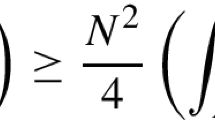Abstract
Hyperbolic geometry can be axiomatized using the notions of order andcongruence (as in Euclidean geometry) or using the notion of incidencealone (as in projective geometry). Although the incidence-based axiomatizationmay be considered simpler because it uses the single binary point-linerelation of incidence as a primitive notion, we show that it issyntactically more complex. The incidence-based formulation requires some axioms of the quantifier-type \forall\exists\forall, while the axiom system based on congruence and order can beformulated using only \forall\exists-axioms.
Similar content being viewed by others
REFERENCES
Chang, C. C.: 1959, ‘On Unions of Chains of Models’, Proc. Amer. Math. Soc. 10 120–127.
Chang, C. C. and H. J. Keisler: 1990, Model Theory, North-Holland, Amsterdam.
Frenkian, A.: 1940, Le postulat chez Euclide et chez les modernes, Librairie Philosophique J. Vrin, Paris.
Hilbert, D.: 1999, Grundlagen der Geometrie, Vol. 14, B. G. Teubner, Auflage (1st edn 1899).
Hodges, W.: 1993, Model Theory. Cambridge University Press, Cambridge.
Keisler, H. J.: 1960, ‘Theory of Models with Generalized Atomic Formulas’, J. Symb. Logic 25, 1–26.
Knorr, W. R.: 1983, ‘Construction as Existence Proof in Ancient Geometry’, Ancient Philos. 3, 125–148.
Knorr, W. R.: 1986, The Ancient Tradition of Geometric Problems, Birkhäuser, Boston, (Dover, New York, 1993).
Kordos, M. and L. W. Szczerba: 1969, ‘On the ∏∑-Axiom Systems of Hyperbolic and Some Related Geometries’, Bull. Acad. Polon. Sci. Sér. Sci. Math. Astronom. Phys. 17, 175–180.
Lombard, M. and R. Vesley: 1998, ‘A Common Axiom Set for Classical and Intuitionistic Plane Geometry’, Ann. Pure Appl. Logic 95, 229–255.
Łoś, J. and R. Suzzko: 1997, ‘On the Extending of Models. IV’, Fund. Math. 44: 52–60.
Mäenpää, P.: 1997, ‘From Backward Reduction to Configurational Analysis’, in M. Otte and M. Panza (eds), Analysis and Synthesis in Mathematics, Boston Stud. Philos. Sci., 196, Kluwer, Dordrecht, pp. 201–226.
Menger, K.: 1971, ‘The New Foundation of Hyperbolic Geometry’, in A Spectrum of Mathematics (Essays presented to H. G. Forder), Auckland University Press, Auckland, pp. 86–97.
Moler, N. and P. Suppes, P.: 1968, 'Quantifier-Free Axioms for Constructive Plane Geometry, Compositio Math. 20, 143–152.
Niebel, E.: 1959, Untersuchungen über die Bedeutung der geometrischen Konstruktion in der Antike, Kant-Studien, Ergänzungsheft 76, Kölner-Universitäts-Verlag.
Pambuccian, V.: 2001, ‘Constructive Axiomatizations of Plane Absolute, Euclidean and Hyperbolic Geometry’, Math. Log. Q. 47, 129–135.
Pambuccian, V.: 2001, ‘Fragments of Euclidean and Hyperbolic Geometry’, Sci. Math. Jpn. 53, 361–400.
Pambuccian, V.: 2002, ‘Sphere Tangency as Single Primitive Notion for Hyperbolic and Euclidean Geometry’, submitted.
Poincaré, H.: 1903, La science et l'hypothèse, Flammarion, Paris.
Proclus:1970, A Commentary on the First Book of Euclid's Elements,(trans.G.R. Morrow), Princeton University Press, Princeton.
Schwabhäuser, W.: 1959, ‘Entscheidbarkeit und Vollständigkeit der elementaren hyperbol-ischen Geometrie’, Z. Math. Logik Grundlagen Math. 5, 132–205.
Schwabhäuser, W., W. Szmielew, and A. Tarski: 1983, Metamathematische Methoden in der Geometrie, Springer-Verlag, Berlin.
Skala, H.: 1992, ‘Projective-Type Axioms for the Hyperbolic Plane’, Geom. Dedicata 44, 255–272.
Szmielew, W.: 1959, ‘Some Metamathematical Problems Concerning Elementary HyperbolicGeometry’,in L. Henkin, P. Suppes, and A. Tarski (eds), The Axiomatic Method, North-Holland, Amsterdam, pp. 30–52.
Tarski, A.: 1954, ‘Contributions to the Theory of Models. I, II’, Nederl. Akad. Wetensch. Proc. Ser. A 57 = Indagationes Math. 16, 572–581, 582-588.
Tarski, A.: 1959, ‘What is Elementary Geometry?’, in L. Henkin, P. Suppes, and A. Tarski (eds), The Axiomatic Method, North-Holland, Amsterdam, pp. 16–29.
Tarski, A. and Givant, S.: 1999, ‘Tarski's System of Geometry’, Bull. Symbolic Logic 5, 175–214.
van der Waerden, B. L.: 1977/1978, ‘Die Postulate und Konstruktionen in der frühgriechischen Geometrie’, Arch. Hist. Exact Sci. 18, 343–357.
Vesley, R.: 1999, ‘Constructivity in Geometry’, Hist. Philos. Logic 20, 291–294.
Zeuthen, H. G.: 1896, ‘Die geometrische Construction als “Existenzbeweis” in der antiken Geometrie’, Math. Ann. 47, 222–228.
Author information
Authors and Affiliations
Rights and permissions
About this article
Cite this article
Pambuccian, V. Axiomatizations of Hyperbolic Geometry: A Comparison Based on Language and Quantifier Type Complexity. Synthese 133, 331–341 (2002). https://doi.org/10.1023/A:1021294808742
Issue Date:
DOI: https://doi.org/10.1023/A:1021294808742



